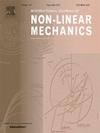Stability of Poiseuille flow of a viscoelastic fluid in an anisotropic porous layer with oblique principal axes
IF 2.8
3区 工程技术
Q2 MECHANICS
International Journal of Non-Linear Mechanics
Pub Date : 2025-02-10
DOI:10.1016/j.ijnonlinmec.2025.105046
引用次数: 0
Abstract
This study investigates the hydrodynamic stability of fluid flow in a horizontal anisotropic porous layer, where the saturating fluid is a Navier-Stokes-Voigt type of viscoelastic fluid, with Darcy and Brinkman terms. The permeability exhibits transverse isotropy, but intriguingly, the orientation of the longitudinal principal axes remains arbitrary. This configuration is sufficient to produce qualitatively novel flow patterns, such as a tilted plane of motion or inclined lateral cell walls. The Chebyshev collocation method is adopted to obtain the generalized eigenvalue problem, which is then solved numerically. The analysis traces neutral stability curves, defining the threshold for instability and identifies the critical Reynolds number for different values of the Kelvin-Voigt parameter, the porous parameter, the ratio of effective viscosity to fluid viscosity, the mechanical anisotropy parameter and the orientation angle of the principal axis. Instability is observed exclusively within a specific range of the Kelvin-Voigt parameter, which is significantly influenced by other governing parameters. Remarkably, the emergence of closed neutral stability curves is identified indicating the necessity of two distinct Reynolds numbers to fully characterize the linear stability of the base flow. The orientation angle is found to either stabilize or destabilize the fluid flow, depending on the value of anisotropy parameter. Additionally, this research revisits the isotropic case, correcting an incomplete analysis by Kumar et al. (Int. J. Non-Linear Mech. vol. 167, pp. 104885, 2024) and providing accurate numerical solution as a comprehensive correction to their work.
斜主轴各向异性多孔层中粘弹性流体泊泽维尔流动的稳定性
本文研究了水平各向异性多孔层中流体流动的水动力稳定性,其中饱和流体为具有Darcy和Brinkman项的Navier-Stokes-Voigt型粘弹性流体。渗透率表现出横向各向同性,但有趣的是,纵向主轴的方向仍然是任意的。这种结构足以产生定性新颖的流动模式,例如倾斜的运动平面或倾斜的侧细胞壁。采用切比雪夫配点法得到广义特征值问题,并对其进行数值求解。分析跟踪中性稳定性曲线,定义不稳定阈值,确定不同值Kelvin-Voigt参数、孔隙参数、有效粘度与流体粘度之比、力学各向异性参数和主轴取向角时的临界雷诺数。不稳定性只在Kelvin-Voigt参数的特定范围内观察到,该范围受其他控制参数的显著影响。值得注意的是,发现了封闭中性稳定性曲线的出现,这表明需要两个不同的雷诺数来充分表征基流的线性稳定性。根据各向异性参数的取值,发现取向角可以稳定流体流动,也可以破坏流体流动。此外,本研究重新审视了各向同性的情况,纠正了Kumar等人的不完整分析。J.非线性机制。第167卷,第104885,2024),并提供准确的数值解决方案,全面纠正他们的工作。
本文章由计算机程序翻译,如有差异,请以英文原文为准。
求助全文
约1分钟内获得全文
求助全文
来源期刊
CiteScore
5.50
自引率
9.40%
发文量
192
审稿时长
67 days
期刊介绍:
The International Journal of Non-Linear Mechanics provides a specific medium for dissemination of high-quality research results in the various areas of theoretical, applied, and experimental mechanics of solids, fluids, structures, and systems where the phenomena are inherently non-linear.
The journal brings together original results in non-linear problems in elasticity, plasticity, dynamics, vibrations, wave-propagation, rheology, fluid-structure interaction systems, stability, biomechanics, micro- and nano-structures, materials, metamaterials, and in other diverse areas.
Papers may be analytical, computational or experimental in nature. Treatments of non-linear differential equations wherein solutions and properties of solutions are emphasized but physical aspects are not adequately relevant, will not be considered for possible publication. Both deterministic and stochastic approaches are fostered. Contributions pertaining to both established and emerging fields are encouraged.

 求助内容:
求助内容: 应助结果提醒方式:
应助结果提醒方式:


